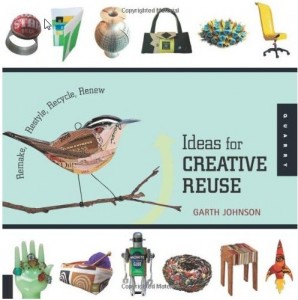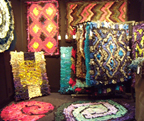If you’re looking for ideas for crafts to make from recycled materials, get this book: 1000 Ideas for Creative Reuse, by Garth Johnson. It is simply the richest source of ideas, per book-dollar or per page, I have found.

Read the comments and the reviews about the book; if you’re looking for step-by-step instructions, you need to keep looking. I don’t do step-by-steps outside of chainsaw carving.
My own textile work is made almost exclusively from recycled materials, using discarded clothing and donated fabric, household linens, and other fibers. I have access to a rich stream of old clothes, in the form of thrift shops, personal donations, yard sales, and storage unit auctions. I also have a spare bedroom turned over to storage space for this fiber.
Artist Joel Haas pointed out that if you really want to get good at a particular recycled material craft, it is wise to make sure you have reliable access to your raw material. He made owls from freon canisters, back in the day when every auto mechanic kept freon in the shop to recharge a/c systems. As the coolant changed, Joel got out of the owl business.
Based on my own experience and that of other artists working with “found” and recycled materials, the real challenges are not so much the ideas themselves, as they are the stockpiling, inventory, and management of stash. Sources for ideas are everywhere. It’s collecting enough material to make the idea cool, rather than strange, that’s the problem. One bowling ball as yard art? OK. 20? a whole different matter. (Find a serious bowler–they have closets full of old bowling balls they’d love to give away.)
You will have to create your own rules or guidelines for how you handle your incoming material.
- How will you sort and store it?
- How much can / will you accumulate before you turn it into the final project?
- How will you process it before you store it?
Any fiber that comes into my home gets washed and machine dried before it moves into my studio. I accumulate old clothing in the basement laundry room, which doesn’t share HVAC with the rest of the house. I can’t afford for my house to take on the aroma of a thrift shop… (For that matter, I NEVER bring home clothes from a smoker…) Once washed, I slice up clothing into flat-fold fabric, discarding seams, labels, and stained or torn parts.
One of my weaving friends does not like to accumulate raw material in her studio, so she processes and weaves any new fiber just as fast as she acquires it. This is a choice. I think it limits her ability to mix and match colors, but I have to admit, her studio is neater and easier to work in than mine is! I sort fabric by color in stackable transparent plastic bins.
The metal workers who run a foundry across the street accumulate old cast iron, often in the form of hot water radiators, until they’re ready to run the smelter and have an iron pour. It doesn’t matter if the iron rusts a little, and we have no appearance commission or HOA that will tell them to cover their piles. Your situation may be different.
If you have a particular recycled material available, and you’re looking for something to make from it, try Google. Reuse jeans. Reuse t-shirts. And so forth. However, if you simply want a source of ideas, look at the book mentioned above and let your mind go to work. In no time at all, you’ll see your discard stream very differently.

